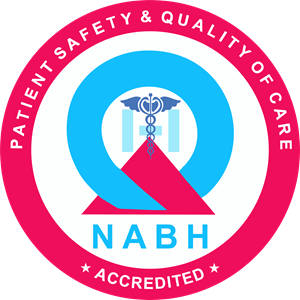Pain Medicine

Dr. Akhil Bhalla
MBBS MD FIPM FIAPM
- Fellowship in Pain Medicine (D Y Patil University, Mumbai)
- Fellowship of Indian Academy of Pain Medicine (Indian Society for Study of Pain)
- Interventional Spine and Pain Specialist
Pain Medicine is a discipline of medicine is devoted to diagnosing and treating pain-related disorders. Interventional Pain Medicine department is set up with the goal of providing the highest quality pain management care to every patient. Whether pain is the result of an injury or from another condition, we offer many different treatment options.
This Spine & Pain Centre utilizes a comprehensive approach and cutting-edge therapies to restore normal function and allow patients to regain an active lifestyle while minimizing the need for opioids and analgesics. As our patient, you are our top priority. Our goal is to help you achieve the best possible quality of life.
Interventional pain management aims to relieve or manage pain to improve the patient’s overall quality of life through minimally invasive techniques. The typical candidates for interventional pain management are patients who have failed to find pain relief with conservative therapies.
Pain Medicine is a discipline of medicine is devoted to diagnosing and treating pain-related disorders. Interventional Pain Medicine department is set up with the goal of providing the highest quality pain management care to every patient. Whether pain is the result of an injury or from another condition, we offer many different treatment options.
This Spine & Pain Centre utilizes a comprehensive approach and cutting-edge therapies to restore normal function and allow patients to regain an active lifestyle while minimizing the need for opioids and analgesics. As our patient, you are our top priority. Our goal is to help you achieve the best possible quality of life.
Interventional pain management aims to relieve or manage pain to improve the patient’s overall quality of life through minimally invasive techniques. The typical candidates for interventional pain management are patients who have failed to find pain relief with conservative therapies.
Interventional pain management can be a useful alternative for chronic pain sufferers who have not had relief from other pain management procedures.
It is estimated that at least more than 80 percent people suffer with chronicpain. For many, the pain makes it difficult to sleep, while affecting energy levels and the ability to perform normal daily activities.
In some cases, where surgery is usually suggested as the last resort, patients can be effectively treated with interventional pain management procedures, MIPSI (Minimally Invasive Pain and Spine Interventions) and provide long term pain relief with improved quality of life.
Pain medicine, also known as analgesics, refers to medications that are used to alleviate or manage pain. There are various types of pain medicine available, ranging from over-the-counter (OTC) options to prescription medications. The choice of pain medicine depends on the severity and type of pain, as well as individual factors such as medical history, allergies, and existing medications.
Here are some common types of pain medicine:
1. Nonsteroidal anti-inflammatory drugs (NSAIDs): NSAIDs, such as ibuprofen, naproxen, and aspirin, are commonly used for mild to moderate pain relief. They reduce inflammation, which can help alleviate pain caused by conditions such as headaches, muscle aches, menstrual cramps, and joint pain.
2. Acetaminophen: Acetaminophen, commonly known as paracetamol, is an OTC pain reliever that is effective for mild to moderate pain, including headaches, toothaches, and minor musculoskeletal discomfort. It is not an anti-inflammatory medication, so it may be a suitable alternative for individuals who cannot take NSAIDs due to certain medical conditions or allergies.
3. Opioids: Opioids, such as codeine, morphine, oxycodone, and hydrocodone, are prescription medications used for severe pain relief. They work by binding to opioid receptors in the brain and spinal cord, reducing the perception of pain. Opioids are typically prescribed for short-term use or in specific situations, such as after surgery or for managing cancer-related pain. They can have side effects and carry a risk of dependence and addiction, so they should be used with caution under medical supervision.
4. Adjuvant medications: In some cases, certain medications that are not primarily designed for pain relief may be used to help manage pain. For example, antidepressants and anticonvulsants may be prescribed for chronic pain conditions like neuropathic pain or fibromyalgia.
ONGOING
1. Evaluation of ovarian masses in reproductive age group by :- Dr Satwant Kaur, Dr Beena.
2. Clinical audit of whole blood and blood components in obstetrics at a tertiary level hospital in developing nation by :-Dr. Harneet Kaur.
3. Pap Smear screening in antenatal period A hospital – based study by :- Dr. Moneet walia.
2022-International
1. Clinical audit of Pap Smear4 test for screening of premalignat and malignant cervical lesions int. j Reprod contracept Obstet Gynecol.2022 Nov.11(11)3161-3164. Tanya Kumar – 1 , Ankit Aneja, Satwant Kur – 2 , Sandhya P. GuliaA – 3.
2. Medical Stdents And COVID-19 Knowledge attitude and practices, Dr. Moneet Walia , Dr. Nidhi Sahrma.
What benefits can all patients receive from interventional pain medicine?
– Scope Of ServicesSerial No Pain Condition 1 Back Pain and Sciatica 2 Complex Regional Pain Syndrome (CRPS) 3 Chronic Post-Surgical Pain 4 Cancer Pain 5 Coccyx Pain 6 Fibromyalgia/ Widespread Pain 7 Headaches 8 Musculoskeletal Pain 9 Knee Pain 10 Neck (Cervical) and Arm Pain 11 Neuropathic Pain 12 Pelvic Pain 13 Post Herpetic Neuralgia 14 Sacroiliac Joint Pain 15 Shoulder Pain/ Frozen Shoulder 16 Sports Injury 17 Thoracic spine and Chest wall Pain 18 Peripheral Neuropathies and Entrapment Syndromes
Radiofrequency Nerve Ablation is the use of radiofrequency waves to heat and destroy nerve tissue, thus reducing pain signals that are emitted from the source. Performed using fluroscopy guidance, radiofrequency nerve ablation delivers precisely controlled heat to temporarily and selectively disable nerves identified as being responsible for pain. Discography is done to determine if the intervertebral discs are the source of pain. Percutaneous Discectomy/Nucleoplasty is a procedure to remove tissue from the spinal disc in order to decompress and relieve pressure. Injections. Steroid injections target pain points in the body to reduce inflammation. Commonly administered injections are muscle and joint injections. Additionally, facet joint, trigger point, and epidural injections can help relieve pain resulting from osteoarthritis and other inflammatory conditions. Pain Pump. This device is surgically implanted and delivers pain medications directly to the location where the pain originates. Nerve, root, and medial branch blocks are procedures that interrupt the nerve-to-brain signals to relieve pain. The block can also help reduce inflammation. Sometimes a block is used as a diagnostic tool. Rhizotomy is a procedure using heated electrodes that “turns off” pain signals when applied to specific nerves. Spinal Cord Stimulation is the application of an electrical current to the source of pain via a tiny, implanted medical device. The electrical signals block the brain’s ability to perceive pain signals.
– Advanced MIPSIs (Minimally Invasive Pain and Spine Interventions) – Ultrasound Guided and Fluoroscopy guided procedures
Cervical Spine Interventions
| S.No | Procedure |
|---|---|
| 1 | Cervical Interlaminer Neuroplasty |
| 2 | Cervical Transforaminal Neuroplasty |
| 3 | Cervical Facet Joint/MB Block |
| 4 | Cervical MB Radiofrequency Ablation/ Neurotomy |
| 5 | Stellate Ganglion Nerve Block/ RFA |
| 6 | Cervical Selective Nerve Block/ RFA |
Lumbo-Sacral Interventions
| S. No | Procedure |
|---|---|
| 1 | Lumbar Selective Nerve Root Neuroplasty |
| 2 | Lumbar Transforaminal Neuroplasty |
| 3 | Caudal Epidural Neuroplasty |
| 4 | Lumbar Facet Joint/MB Block |
| 5 | Lumbar MB Radiofrequency Ablation/ Neurotomy |
| 6 | Celiac Plexus Neurolysis |
| 7 | Lumbar Sympathetic Neurolysis |
| 8 | Hypogastric Plexus Neurolysis |
| 9 | Ganglion Impar Block/ Neurolysis |
| 10 | Ganglion Impar Block/ Neurolysis |
| 11 | Percutaneous Lumbar Disk Decompression |
| 12 | Percutaneous Interlaminer Laminectomy Decompression (PILD) |
| 13 | Sacroiliac Joint Block |
| 14 | Sacroiliac Joint Radiofrequency Ablation/ Neurotomy |
| 15 | Percutaneous epidural Adhesiolysis |
Cranio-facial Interventions
| Serial No | Procedure |
|---|---|
| 1 | Occipital Nerve Blocks/ RF Ablation |
| 2 | Supraorbital Nerve Blocks/ RF Ablation |
| 3 | Sphenopalatine Ganglion Blocks/ RF Ablation |
| 4 | Gasserion ganglion/ Trigeminal RFA |
| 5 | Occipital Nerve Stimulator Trials/ Surgical Implants |
| 6 | Botox Treatment for Migraine Headache |
| 7 | Auriculotemporal Nerve Block |
Peripheral Nerve Blocks (Advanced Ultrasound Guided MIPSI)
| Serial No | Procedure |
|---|---|
| 1 | Lateral Femoral Cutaneous Nerve Block |
| 2 | Saphenous Nerve Block |
| 3 | Ilioinguinal Nerve Cryoablation/ Genitofemoral Nerve Blocks / Ablations |
| 4 | Carpal Tunnel Hydrodissection (Median Nerve) |
| 5 | Trigger Point Injections |
| 6 | Morton’s Neuroma |
| 7 | Piriformis Nerve Block |
| 8 | Quadratus Lumborum Muscle Injection |
| 9 | Intercostal Nerve Block / RF Ablation |
Peripheral Joints/Bursa/Tendon Sheath
| Serial No | Procedure |
|---|---|
| 1 | Hip/ Knee/ Ankle/ Feet Joints |
| 2 | Shoulder/ Elbow/ Wrist/ Hand Joints |
| 3 | Knee & Hip Joints Cooled Radiofrequency Ablation |
| 4 | Skin Biopsies for Neuropathy |
| 5 | Peripheral Major & Minor Bursa Block |
| 6 | Peripheral Major & Minor Bursa Block |
| o Biceps tendon sheath injection o Epicondylar Iliopsoas Block o De Quervain Tendon Sheath Prolotherapy |
Hospital Department
- Contact us
- info@amch.ac.in
- Ambulance: 8222954130
- Phone: 0171-2700000, 2700001
- Emergency: 8222954101
- NH - 44, VILL. MOHRI, SHAHBAD (M), DIST. KURUKSHETRA PIN 136135


